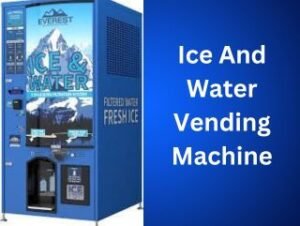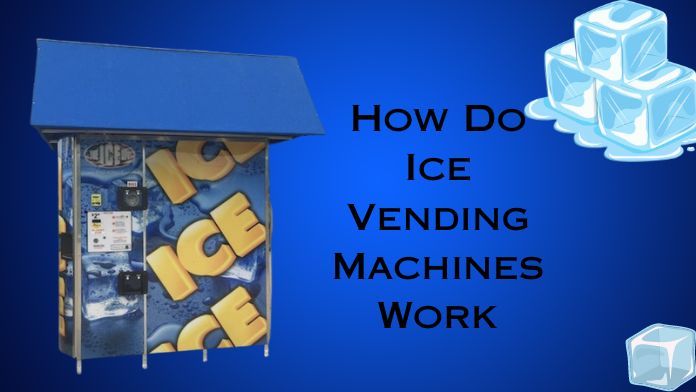Ice vending machines have become a convenient and reliable way to access ice, especially during scorching summers or events that demand large amounts of ice. These machines have gained popularity for their accessibility and ease of use. But have you ever wondered how these ice vending machines work? Let’s dive into the mechanics behind these frozen wonders.
How does the sale of ice work?
Ice vending machines automatically produce and dispense ice. They use built-in ice makers to freeze water in cubes or other shapes, storing the ice in isolated compartments. Users select the desired amount of ice and write through a payment-enabled interface.
Once payment is made, the chosen ice is dispensed into the customer’s container. These machines offer convenient access to ice at multiple locations and are equipped with safety features to ensure ice quality. Maintenance and replacement are necessary to keep machines running.
The freezing process
Ice vending machines begin the process by freezing purified water. The water comes from a clean and treated supply to guarantee the ice quality produced. Water quickly cools to a temperature below freezing, causing it to solidify and form ice.
Filtration and purification of water
Before freezing, the water undergoes filtration and purification to remove impurities or contaminants. This step is crucial to maintaining the ice’s flavor and quality. High-quality water also prevents the formation of cloudy ice cubes.
Ice formation
The freezing process is controlled to create clear, solid ice cubes. The machines ensure the ice is free of air bubbles and impurities, resulting in a visually appealing and refreshing product.
Storage and Maintenance
Once the ice is formed, it is stored in a hygienic, insulated compartment within the machine. This storage unit is designed to keep ice at a low temperature, preventing it from melting or clumping.
How Profitable are Ice Vending Machines?
Ice vending machines can be profitable due to low labor and operating costs. Profits depend on factors such as machine location, maintenance, and demand. High-traffic areas often produce better returns.
Initial investment and maintenance expenses affect profitability, but the convenience and demand for affordable ice can make selling ice a potentially lucrative business venture.
Friendly Interface
Ice vending machines feature an intuitive user interface that allows customers to select the amount of ice they need. The interface is designed to be easy to use and navigate, ensuring a seamless experience for users.
Payment System with Coin or Card
Customers can choose between payment methods to access the ice, such as coins, bills or card payments. This versatility in payment options enhances the convenience of using ice vending machines.
Dispensing Mechanism
When a customer pays, the machine dispenses the selected amount of ice into the chosen container. The dispensing mechanism guarantees precision and prevents any spillage.
24/7 Vending of Ice With No Person-To-Person Contact
Ice vending machines allow 24-hour ice vending without human interaction. Customers can purchase ice anytime, and the machine dispenses their chosen amount and type automatically.
This contactless system offers convenience and accessibility, making it ideal for various locations where people need ice without relying on specific hours of operation or staff.
Security Measures
Ice vending machines have security features to prevent unauthorized access or tampering. These measures include surveillance cameras, robust construction, and anti-theft mechanisms.
Benefits of Ice Vending Machines
Ice vending machines offer 24/7 access to ice without staff. They provide convenient, contactless service, meeting various needs such as refrigeration, events and beverages. They reduce human labor, offer profit potential, and are strategically located for easy access, making them a valuable addition in many locations.
Environmental Impact
Ice vending machines typically use energy-efficient technologies and require minimal water, making them more environmentally friendly than traditional ice-making methods.
Cost-Effectiveness
Investing in an ice vending machine can be profitable for businesses as it requires less labor and maintenance than traditional ice vending.
Availability and Convenience
Ice vending machines provide 24/7 access to ice, ensuring customers can get ice during store hours.
Maintain Hygiene
The automated ice vending process reduces the need for direct human contact with the ice, promoting a higher level of hygiene and sanitation.
What you should know before buying ice vending machines
Before purchasing an ice vending machine:
- Consider machine size, capacity, location, and potential demand.
- Research various models and makes, understanding their features, costs, and maintenance requirements.
- Evaluate the target market and location for optimal placement.
- Evaluate local regulations and permits.
- Estimate initial costs, installation and ongoing expenses.
Thorough research ensures a successful investment in ice vending machines.
Dry Ice Vending Machine
A dry ice vending machine offers automated access to dry ice, a solid form of carbon dioxide. Users can purchase specific amounts of dry ice through a user interface and payment system.
The machine dispenses dry ice into containers without human assistance, providing a convenient solution for industries such as food transportation, medicine, and special effects, where dry ice is needed for cooling and fogging effects.
Ice Cube Vending Machine
An ice cube vending machine provides convenience by offering customers automated access to ice cubes. Users can choose their needed amount and make payments through the machine’s interface.
These machines are commonly found in places like gas stations, campgrounds, and convenience stores, which serve the ice needs of the people.
Ice Vending Vs. Water Vending Machines
Ice vending machines dispense ice cubes or nuggets for cooling and preservation, while water vending machines provide purified drinking water. Here are some differences between them:

| Aspect | Ice Vending Machines | Water Vending Machines |
| Product Offered | Dispenses ice cubes or nuggets | Dispenses purified water |
| Use Cases | Cooling, beverages, preservation | Drinking, hydration |
| Machine Complexity | Ice-making, storage, dispensing | Filtration, purification, filling |
| Types of Payments | Cash, cards, mobile payments | Coins, cards, mobile payments |
| Demand Variability | Seasonal, location-dependent | More consistent, year-round |
| Maintenance Needs | Ice maker maintenance, restocking | Filter changes, machine upkeep |
| Industry Applications | Hospitality, events, retail | Gyms, schools, public spaces |
| Environmental Impact | Energy for freezing, packaging waste | Plastic waste, water purification |
| Profit Potential | Variable based on location dema | Steady demand, repeat customers |
How Much Do Ice Vending Machines Cost?
The cost of ice vending machines varies widely based on factors such as size, capacity, features, and brand. Basic models can start around $10,000, while larger, more advanced machines can range from $20,000 to $50,000. Additional expenses include installation, maintenance, and restocking. It is crucial to consider these factors when estimating the total cost of owning an ice vending machine.
FAQ
Are Ice Vending Machines Energy Efficient?
Ice vending machines often incorporate energy-saving technologies to minimize their environmental impact.
Can I Choose the Size of the Ice Pack I Want?
Absolutely! Ice vending machines often offer different size options to meet your specific needs.
How Do you Prevent Ice from Melting in the Machine?
The ice storage compartment is well insulated and cooled, which prevents the ice from melting quickly.
Are Ice Vending Machines Easy to Maintain?
Yes, these machines are designed for low maintenance and require regular cleaning and maintenance.
Do Ice Vending Machines Require a Water Connection?
Ice vending machines are usually connected to a water supply for ice production but require minimal water use.
Conclusion
The mechanics of ice vending machines simplify ice acquisition. These machines freeze purified water, ensure quality through filtration, and form clear, solid ice. User-friendly interfaces, secure mechanisms, and environmental efficiency further enhance their appeal. Ice vending machines redefine convenience, providing a reliable solution for ice needs.

